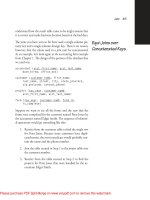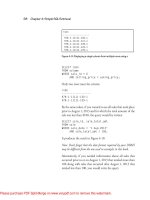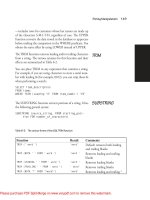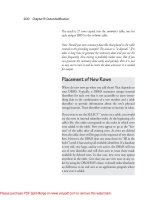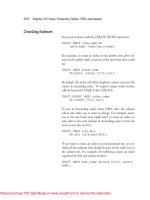- Trang chủ >>
- Khoa Học Tự Nhiên >>
- Vật lý
Geostatistics explained
Bạn đang xem bản rút gọn của tài liệu. Xem và tải ngay bản đầy đủ của tài liệu tại đây (2.92 MB, 414 trang )
This page intentionally left blank
Geostatistics Explained
An Introductory Guide for Earth Scientists
This reader-friendly introduction to geostatistics provides a lifeline for
students and researchers across the Earth and environmental sciences who
until now have struggled with statistics. Using simple and clear explanations for both introductory and advanced material, it demystifies complex concepts and makes formulas and statistical tests easy to understand
and apply.
The book begins with a discussion and critical evaluation of experimental
and sampling design before moving on to explain essential concepts of
probability, statistical significance and Type 1 and Type 2 error. Tests for one
and two samples are presented, followed by an accessible graphical explanation of analysis of variance (ANOVA). More advanced ANOVA designs,
correlation and regression, and non-parametric tests including chi-square,
are then considered. Finally, it introduces the essentials of multivariate
techniques such as principal components analysis, multidimensional
scaling and cluster analysis, analysis of sequences (especially autocorrelation
and simple regression models) and concepts of spatial analysis, including
the semivariogram and its application in Kriging.
Illustrated with wide-ranging and interesting examples from topics
across the Earth and environmental sciences, Geostatistics Explained
provides a solid grounding in the basic methods, as well as serving as a
bridge to more specialized and advanced analytical techniques. It can be
used for an undergraduate course or for self-study and reference. Worked
examples at the end of each chapter help reinforce a clear understanding
of the statistical tests and their applications.
Steve McKillup is an Associate Professor in the Department of
Biosystems and Resources at Central Queensland University. He has
received several tertiary teaching awards, including the Vice-Chancellor’s
Award for Quality Teaching and a 2008 Australian Learning and Teaching
Council citation “For developing a highly successful method of teaching
complex physiological and statistical concepts, and embodying that method
in an innovative international textbook.” He is the author of Statistics
Explained: An Introductory Guide for Life Scientists (Cambridge, 2006).
His research interests include biological control of introduced species, the
ecology of soft-sediment shores and mangrove swamps.
Melinda Darby Dyar is an Associate Professor of Geology and
Astronomy at Mount Holyoke College, Massachusetts. Her research
interests range from innovative pedagogies and curricular materials to
the characterization of planetary materials. She has studied samples from
mid-ocean ridges and every continent on Earth, as well as from the lunar
highlands and Mars. She is a Fellow of the Mineralogical Society of
America, and the author or coauthor of more than 130 refereed journal
articles. She is the author of two mineralogy DVDs used in college-level
teaching, and a textbook, Mineralogy and Optical Mineralogy (2008).
Geostatistics Explained
An Introductory Guide for Earth Scientists
STEVE McKILLUP
Central Queensland University
MELINDA DARBY DYAR
Mount Holyoke College, Massachusetts
CAMBRIDGE UNIVERSITY PRESS
Cambridge, New York, Melbourne, Madrid, Cape Town, Singapore,
São Paulo, Delhi, Dubai, Tokyo
Cambridge University Press
The Edinburgh Building, Cambridge CB2 8RU, UK
Published in the United States of America by Cambridge University Press, New York
www.cambridge.org
Information on this title: www.cambridge.org/9780521763226
© Steve McKillup and Melinda Darby Dyar 2010
This publication is in copyright. Subject to statutory exception and to the
provision of relevant collective licensing agreements, no reproduction of any part
may take place without the written permission of Cambridge University Press.
First published in print format 2010
ISBN-13
978-0-511-67730-4
eBook (NetLibrary)
ISBN-13
978-0-521-76322-6
Hardback
ISBN-13
978-0-521-74656-4
Paperback
Cambridge University Press has no responsibility for the persistence or accuracy
of urls for external or third-party internet websites referred to in this publication,
and does not guarantee that any content on such websites is, or will remain,
accurate or appropriate.
Contents
Preface
page xv
1
1.2
Introduction
Why do earth scientists need to understand experimental
design and statistics?
What is this book designed to do?
2
2.1
2.2
2.3
2.4
2.5
2.6
2.7
2.8
“Doing science”: hypotheses, experiments and disproof
Introduction
Basic scientific method
Making a decision about a hypothesis
Why can’t a hypothesis or theory ever be proven?
“Negative” outcomes
Null and alternate hypotheses
Conclusion
Questions
8
8
8
11
11
12
12
13
14
3
3.1
3.2
3.3
3.4
3.5
3.6
3.7
3.8
3.9
Collecting and displaying data
Introduction
Variables, sampling units and types of data
Displaying data
Displaying ordinal or nominal scale data
Bivariate data
Data expressed as proportions of a total
Display of geographic direction or orientation
Multivariate data
Conclusion
15
15
15
17
21
21
25
26
26
27
1
1.1
1
6
v
vi
Contents
4
4.1
4.2
4.3
4.4
4.5
4.6
4.7
4.8
4.9
Introductory concepts of experimental design
Introduction
Sampling: mensurative experiments
Manipulative experiments
Sometimes you can only do an unreplicated experiment
Realism
A bit of common sense
Designing a “good” experiment
Conclusion
Questions
28
28
29
34
40
41
42
43
44
44
5
5.1
5.2
5.3
5.4
5.5
5.6
Doing science responsibly and ethically
Introduction
Dealing fairly with other people’s work
Doing the sampling or the experiment
Evaluating and reporting results
Quality control in science
Questions
45
45
45
47
48
50
50
6
6.4
6.5
6.6
6.7
6.8
6.9
6.10
6.11
Probability helps you make a decision about
your results
Introduction
Statistical tests and significance levels
What has this got to do with making a decision or
statistical testing?
Making the wrong decision
Other probability levels
How are probability values reported?
All statistical tests do the same basic thing
A very simple example: the chi-square test for goodness of fit
What if you get a statistic with a probability of exactly 0.05?
Conclusion
Questions
7
7.1
7.2
Working from samples: data, populations and statistics
Using a sample to infer the characteristics of a population
Statistical tests
6.1
6.2
6.3
51
51
52
57
57
58
60
60
60
64
65
65
66
66
66
Contents
7.3
7.4
7.5
7.6
7.7
7.8
7.9
7.10
7.11
7.12
8
8.1
8.2
8.3
8.4
8.5
8.6
8.7
8.8
8.9
8.10
9
9.1
9.2
9.3
9.4
The normal distribution
Samples and populations
Your sample mean may not be an accurate estimate of the
population mean
What do you do when you only have data from one
sample?
Why are the statistics that describe the normal
distribution so important?
Distributions that are not normal
Other distributions
Other statistics that describe a distribution
Conclusion
Questions
Normal distributions: tests for comparing the means
of one and two samples
Introduction
The 95% confidence interval and 95% confidence limits
Using the Z statistic to compare a sample mean and
population mean when population statistics are
known
Comparing a sample mean to an expected value when
population statistics are not known
Comparing the means of two related samples
Comparing the means of two independent samples
Are your data appropriate for a t test?
Distinguishing between data that should be analyzed by
a paired-sample test and a test for two independent
samples
Conclusion
Questions
Type 1 and Type 2 error, power and sample size
Introduction
Type 1 error
Type 2 error
The power of a test
vii
66
71
73
75
78
80
80
82
83
84
85
85
85
86
87
96
98
100
102
103
103
105
105
105
106
109
viii
9.5
9.6
9.7
9.8
10
10.1
10.2
10.3
10.4
10.5
10.6
10.7
11
11.1
11.2
11.3
11.4
11.5
11.6
12
12.1
12.2
12.3
12.4
12.5
12.6
12.7
12.8
12.9
Contents
What sample size do you need to ensure the risk of Type 2
error is not too high?
Type 1 error, Type 2 error and the concept of risk
Conclusion
Questions
111
113
113
114
Single-factor analysis of variance
Introduction
Single-factor analysis of variance
An arithmetic/pictorial example
Unequal sample sizes (unbalanced designs)
An ANOVA does not tell you which particular treatments
appear to be from different populations
Fixed or random effects
Questions
115
115
116
122
128
Multiple comparisons after ANOVA
Introduction
Multiple comparison tests after a Model I ANOVA
An a posteriori Tukey comparison following a significant
result for a single-factor Model I ANOVA
Other a posteriori multiple comparison tests
Planned comparisons
Questions
131
131
131
Two-factor analysis of variance
Introduction
What does a two-factor ANOVA do?
How does a two-factor ANOVA analyze these data?
How does a two-factor ANOVA separate out the effects of
each factor and interaction?
An example of a two-factor analysis of variance
Some essential cautions and important complications
Unbalanced designs
More complex designs
Questions
142
142
145
146
128
128
129
134
138
138
140
150
153
154
164
164
165
Contents
13
13.1
13.2
13.3
13.4
13.5
13.6
13.7
13.8
14
14.1
14.2
14.3
14.4
14.5
14.6
14.7
14.8
15
15.1
15.2
15.3
15.4
15.5
15.6
15.7
15.8
Important assumptions of analysis of variance,
transformations and a test for equality of
variances
Introduction
Homogeneity of variances
Normally distributed data
Independence
Transformations
Are transformations legitimate?
Tests for heteroscedasticity
Questions
Two-factor analysis of variance without replication,
and nested analysis of variance
Introduction
Two-factor ANOVA without replication
A posteriori comparison of means after a two-factor
ANOVA without replication
Randomized blocks
Nested ANOVA as a special case of a single-factor
ANOVA
A pictorial explanation of a nested ANOVA
A final comment on ANOVA: this book is only an
introduction
Questions
Relationships between variables: linear correlation and
linear regression
Introduction
Correlation contrasted with regression
Linear correlation
Calculation of the Pearson r statistic
Is the value of r statistically significant?
Assumptions of linear correlation
Conclusion
Questions
ix
166
166
166
167
171
171
172
174
176
178
178
178
183
184
185
187
192
192
194
194
195
195
196
202
202
202
203
x
Contents
16
16.1
16.2
16.3
16.4
16.5
16.6
16.7
16.8
16.9
16.10
16.11
16.12
16.13
17
17.1
17.2
17.3
18
18.1
18.2
18.3
18.4
18.5
18.6
18.7
18.8
18.9
Linear regression
Introduction
Linear regression
Calculation of the slope of the regression line
Calculation of the intercept with the Y axis
Testing the significance of the slope and the intercept
of the regression line
An example: school cancellations and snow
Predicting a value of Y from a value of X
Predicting a value of X from a value of Y
The danger of extrapolating beyond the range of data
available
Assumptions of linear regression analysis
Multiple linear regression
Further topics in regression
Questions
204
204
204
205
208
Non-parametric statistics
Introduction
The danger of assuming normality when a population
is grossly non-normal
The value of making a preliminary inspection of the data
227
227
Non-parametric tests for nominal scale data
Introduction
Comparing observed and expected frequencies: the
chi-square test for goodness of fit
Comparing proportions among two or more independent
samples
Bias when there is one degree of freedom
Three-dimensional contingency tables
Inappropriate use of tests for goodness of fit and
heterogeneity
Recommended tests for categorical data
Comparing proportions among two or more related
samples of nominal scale data
Questions
230
230
211
217
219
219
220
220
223
224
225
227
229
231
234
237
242
242
243
243
245
Contents
19
19.1
19.2
19.3
19.4
19.5
19.6
19.7
19.8
19.9
19.10
20
20.1
20.2
20.3
20.4
20.5
20.6
20.7
20.8
20.9
20.10
20.11
20.12
20.13
Non-parametric tests for ratio, interval or ordinal scale
data
Introduction
A non-parametric comparison between one sample and
an expected distribution
Non-parametric comparisons between two independent
samples
Non-parametric comparisons among more than two
independent samples
Non-parametric comparisons of two related samples
Non-parametric comparisons among three or more
related samples
Analyzing ratio, interval or ordinal data that show gross
differences in variance among treatments and cannot be
satisfactorily transformed
Non-parametric correlation analysis
Other non-parametric tests
Questions
Introductory concepts of multivariate analysis
Introduction
Simplifying and summarizing multivariate data
An R-mode analysis: principal components analysis
How does a PCA combine two or more variables into one?
What happens if the variables are not highly correlated?
PCA for more than two variables
The contribution of each variable to the principal
components
An example of the practical use of principal components
analysis
How many principal components should you plot?
How much variation must a PCA explain before it is
useful?
Summary and some cautions and restrictions on use of PCA
Q-mode analyses: multidimensional scaling
How is a univariate measure of dissimilarity among
sampling units extracted from multivariate data?
xi
247
247
248
250
256
259
262
264
266
268
268
270
270
271
272
273
276
277
279
282
282
283
283
284
285
xii
20.14
20.15
20.16
Contents
287
289
20.17
20.18
20.19
An example
Stress
Summary and cautions on the use of multidimensional
scaling
Q-mode analyses: cluster analysis
Which multivariate analysis should you use?
Questions
21
21.1
21.2
21.3
21.4
21.5
21.6
21.7
21.8
21.9
21.10
21.11
21.12
21.13
21.14
21.15
21.16
Introductory concepts of sequence analysis
Introduction
Sequences of ratio, interval or ordinal scale data
Preliminary inspection by graphing
Detection of within-sequence similarity and dissimilarity
Cross-correlation
Regression analysis
Simple linear regression
More complex regression
Simple autoregression
More complex series with a cyclic component
Statistical packages and time series analysis
Some very important limitations and cautions
Sequences of nominal scale data
Records of the repeated occurrence of an event
Conclusion
Questions
297
297
298
298
299
307
308
309
311
317
320
322
322
323
327
331
332
22
22.1
22.2
22.3
22.4
22.5
22.6
Introductory concepts of spatial analysis
Introduction
Testing whether a spatial distribution occurs at random
Data for the direction of objects
Prediction and interpolation in two dimensions
Conclusion
Questions
334
334
335
346
352
362
362
23
23.1
Choosing a test
Introduction
364
364
290
291
295
295
Contents
Appendices
Appendix A Critical values of chi-square, t and F
Appendix B Answers to questions
References
Index
xiii
374
380
389
391
Preface
This book presents an introduction to statistical methods that is specifically
written for “earth science” students who do not have a strong background in
mathematics.
The earth sciences are increasingly (and appropriately) recognized as
environmental sciences that overlap and integrate with other disciplines,
especially geography, hydrology, soil science, oceanography, environmental
management, environmental impact assessment, bioremediation, remote
sensing and conservation. As a result, the skills required of earth scientists
have become far more diverse, as have the interests and backgrounds of
students who enroll in these programs. Today’s earth scientists need to be
able to critically evaluate sampling designs, to understand the concept of
statistical analysis, and be able to evaluate and interpret the results of
statistical tests applied in a wide range of fields.
A sound grounding in statistical concepts and methods is especially
important, but an increasing proportion of earth science students do not
have this. Some have told us that math avoidance is the reason why they
have pursued earth sciences instead of chemistry, biology and physics.
Many such students are afraid of mathematics (often because they did
badly in such subjects at high school) and dread doing an introductory
statistics course.
This book has been developed for university and college courses in
introductory geostatistics and as a guide for new users to learn statistics
on their own. We assume very little prior knowledge of mathematics and
start from first principles to develop an understanding of significance testing that can be applied to all statistical tests and related to experimental
design. We use a carefully structured conceptual approach to introduce and
explain what statistical tests actually do, using a minimum of terminology.
Concepts that other introductory texts present as a daunting series of
xv
xvi
Preface
formulae are explained in a way that even the “math-phobic” student will
find refreshing. The examples we have given are deliberately simple to help
the reader understand the statistical concepts being explained. In cases
where we have not given a reference for an example, the data have been
deliberately contrived (or simplified from actual data) for clarity. Perhaps
most importantly, this text develops a strong conceptual understanding that
can be applied to the range of statistical methods used in the geosciences.
If you only take an introductory course, then this book will provide the
background and understanding you need to interpret and critically evaluate
results and summary reports produced by statisticians. If you go on further
in geostatistics, this introduction will serve as a bridge to more advanced
courses that use texts such as Borradaile (2003) Statistics of Earth Science
Data, and Davis (1986, 2002) Statistics and Data Analysis in Geology.
We have many people to thank. Erick Bestland introduced us by email.
Comments by reviewers improved the text. We thank our editors, Susan
Francis and Jon Billam, for their considerable help and their good humor.
Both our families provided enormous support and tolerated a great deal of
absent-mindedness.
For Steve, Ruth McKillup provided constant encouragement and read,
commented on, and reread several drafts. Lynn Stewart’s constructive help
was particularly appreciated, as were Haylee Weaver’s insightful comments.
For Darby, thanks are due to Harold Andrews, who introduced her to
statistics as an undergraduate in a course that has proven useful in many
ways over the years. Tekla Harms humored many thoughtful geologic
discussions at 6 a.m. Peter, Duncan and Lindy Crowley provided necessary
distractions from this project and a constant reminder of what is really
important. At her feet, dogs waited patiently for walks that were postponed
by “one last change” to various chapters; they are glad to know that they will
now have their day!
1
Introduction
1.1
Why do earth scientists need to understand experimental
design and statistics?
Earth scientists face special challenges because the things they study – the
rock formations, ore bodies, deposits of minerals and fossil species – are
often very large, widely dispersed and/or difficult to access. Therefore, it is
usually impossible for an earth scientist to study more than a small fraction
of any geological phenomenon. For example, imagine trying to measure the
length of every brachiopod in the northern hemisphere, the H2O content of
every basalt flow in the USA, the diameter of every volcanic bomb on the
island of Hawaii, or the orientation of every single fault plane in an entire
formation. You would have to take a sample – a small subset of each – and
hope that the results you obtained were representative of the larger group.
Because they are often forced to work with samples, earth scientists need
to know how to sample, and they need to know how confident they can be
about making generalizations from these samples.
The total number of occurrences of a particular thing (e.g. mineral
species, fossil type, rock type) present in a defined area is often called the
population. But because a researcher usually cannot measure every part of
the population (unless they are studying a very restricted location, like the
inside of a volcanic caldera), they have to work with a carefully selected
subset of several sampling units that they hope is a representative sample,
which can be used to infer the characteristics of the population. For example, they might measure the size (usually in terms of diagonal length) of a
sample of fifty megalodon teeth from a population of several hundred, or
assess the quality of a consignment of several thousand agates by breaking
open a randomly chosen sample of twenty. You can also think of the
population as the total number of artificial sampling units possible (e.g. all
the quadrangles in the United States) and your sample being the subset
1
2
Introduction
(e.g. 20 quadrangles) you have chosen to work with as an indication of
conditions across the whole country. The concept of a representative
subset also applies to experiments where you might take two (or more)
samples and expose them to two (or more) different treatments. Here the
replicates within each sample are often called experimental units to emphasize that they have been artificially manipulated. We will usually refer to
replicates as sampling units in this book.
The best way to get a representative sample is usually to choose a
proportion of the population at random – without bias, with every possible
sampling unit having an equal chance of being selected.
Unfortunately it is often very difficult for earth scientists to take a random
sample, because they cannot easily access the whole population. For example, it may only be possible to sample rocks that are exposed in outcrops, but
these may not be the same as the rest of the formation – the outcrops may
only have remained because they have a slightly different composition that
makes them more resistant to weathering. A group of rocks sampled at
random from float may not represent the variability present in all rocks
from that outcrop/formation. Therefore, earth scientists need to know how
to take the best possible sample from the part of the population they can
access, and be aware of the risk of assuming that the sample is characteristic
of the population.
Next, even a random sample may not be a good representative of the
population from which it has been taken. There are often great differences
among sampling units from the same population. This is not restricted to
the earth sciences. Think of the people you have seen today – unless you met
some identical twins (or triplets etc.), no two would have been the same. But
even rock types that seem to be made up of similar-looking minerals show
great variability. This leads to several problems.
First, two samples taken at random from the same population may,
simply by chance, be very different to each other and not very representative of the population (Figure 1.1).
Therefore, if you take a random sample from each of two similar
populations, the samples may be different from each other simply by
chance. On the basis of your samples, you might mistakenly conclude that
the two populations are very different. You need some way of knowing if the
difference between samples is what you would expect by chance, or whether
the populations really do seem to be different.
1.1 Experimental design and statistics
3
Population
Sample 1
Sample 2
Figure 1.1 Even a random sample may not necessarily be a good
representative of the population. Two samples have been taken at random
from a Devonian oil field in Ghawar. By chance, sample 1 contains a group of
relatively large fossils, while those in sample 2 are relatively small, and the
types of fossils in the two samples are also different.
Second, even if two populations are very different, samples from each
may be similar simply by chance, and therefore give the misleading
impression the populations are also similar (Figure 1.2).
Finally, variation within samples may make it difficult to interpret any
effect of differences in location. There is often so much variation within a
sample (and a population) that differences in location may be difficult to
interpret. For example, imagine you are an environmental geologist working to assess a landfill contaminated with lead. The lead content in a sample
4
Introduction
Population 1
Sample 1
Population 2
Sample 2
Figure 1.2 Samples selected at random from very different populations may
not necessarily be different. Simply by chance the samples from populations
1 and 2 are similar in size and composition.
of ten cores from the oldest part of the landfill is 1000 mg/kg Pb on average,
and ranges from 100–9000 mg/kg. In contrast, a sample of ten cores from
the youngest part of the landfill contains 2000 mg/kg Pb on average but
ranges from 100–7000 mg/kg. Which of these two areas would you consider
to be most contaminated?
Variability within samples can also obscure the effect of experimental
treatments. For example, opaque brown topaz crystals may change to
1.1 Experimental design and statistics
5
transparent blue (which people find attractive and pay high prices for) if
they are heat-treated. Gamma irradiation also alters the color of topaz. A
mineralogist found that 60–80% of brown topaz crystals treated by heating
turned various shades of blue. In contrast, when crystals were irradiated and
then heated, a few turned bright blue, but others remained quite brown
(Figure 1.3). From the extremely variable results for the 12 crystals in
Figure 1.3, can you really conclude that irradiation had a significant effect?
Control group (before the experiment)
Treatment group (before the experiment)
Control group (only heated)
Treatment group (heat-treated and irradiated)
Figure 1.3 Two samples of topaz crystals were taken from the same mine and
deliberately matched so that six equally brown individuals were initially
present in each group. Those in the treatment group were treated with 60Co
radiation followed by heating to 450 °C, while those in the control group were
only heated. This caused all crystals to became more translucent and change
color to shades of brown, pink and blue. Slightly more of the crystals in the
treatment group became translucent gemmy and blue, but this difference is
small compared to the variation in color among individuals, which may
obscure any effect of treatment.
6
Introduction
These sorts of problems are usually unavoidable when you work with
samples and mean that a researcher has to take every possible precaution to
try and ensure that their samples are likely to be representative and thus
give a good estimate of conditions in the population. So earth scientists need
to know how to sample. They also need a good understanding of experimental design, because a good sampling design will take natural variation
into account and also minimize additional unwanted variability introduced
by the sampling procedure itself. They also need to take accurate and precise
measurements to minimize other sources of error.
Finally, considering the variability within samples described above, the
results of an experiment may not be clear-cut. So it is often difficult to make
a decision about differences between samples from different populations or
different experimental treatments. Is it the sort of difference you would
expect by chance, or are the populations really different? Is the experimental treatment having an effect? You need something to help you
decide, and that is what statistical tests do, by calculating the probability
of a particular difference among samples. Once you have the probability, the
decision is up to you. So you need to understand how statistical tests work!
1.2
What is this book designed to do?
A good understanding of experimental design and statistics is important,
whether you are a meteorologist, paleontologist, geochemist, seismologist or geographer, so many earth science students are made to take a
general introductory statistics course. A lot of these take a detailed
mathematical approach that students often find uninspiring. This book
is an introduction that does not assume a strong mathematical background. Instead, it develops a conceptual understanding of how statistical
tests actually work, using pictorial explanations where possible and a
minimum of formulae.
If you have read other texts, or already done an introductory course, you
may find that the way this material is presented is unusual, but we have
found that non-statisticians find this approach very easy to understand and
sometimes even entertaining. If you have a background in statistics you may
find some sections a little too explanatory, but at the same time they are
likely to make sense. This book most certainly will not teach you everything
about the subject areas, but it will help you decide what sort of statistical test
1.2 What is this book designed to do?
7
to use and what the results mean. It will also help you understand and
criticize the sampling and experimental designs of others. Most importantly, it will help you design and analyze your own sampling programs
and experiments, understand more complex sampling designs and move on
to more advanced statistical courses


